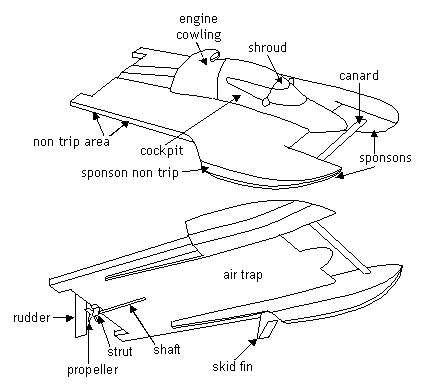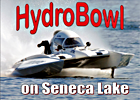 |
| engine
cowling |
The engine cowling is a
light weight fiber glass covering to protect the engine from water.
Often you will see boats racing without an engine cowling.
This is usually because the boat was up side down in a previous race
and the engine cowling is at the bottom of a lake or river
somewhere. |
| shroud |
The shroud is the
covering over the driver to keep water out of boat and the driver's
face. It is not required and some drivers prefer an open
cockpit. |
| canard |
In aeronautics, canard
(French for duck) is an airframe configuration of fixed-wing
aircraft in which the tail plane is ahead of the main wing, rather
than behind them as in conventional aircraft. The earliest
models, such as the Wright Flyer, the world's first airplane, and
the Santos-Dumont 14-bis, were seen by observers to resemble a
flying duck — hence the name. In a hydroplane, the canard is
used to adjust how high the front end flies over the water.
This is usually set to a fixed maximum position and driver has a
foot pedal (some times called the "down" pedal) to lower the from
end. This allows a driver with quick reflexes to possibly
avoid a fly over. |
| cockpit |
The cockpit is the
inside of the safety capsule, where the driver controls the boat.
It contains instruments, a single seat with 5 point harness, and
optionally an air supply for the driver. |
| non-trip |
The non-trip is the side
of the sponson that allows the boat to slide through the turns. |
| sponson |
The trailing bottom
surface of the sponsons (not pontoons) on either side are two of the
points in the 3 point suspension design. The propeller is the
third. |
| skid fin |
The skid fin adds
stability in the straight away with very little drag. In the
turn, the skid fin digs in to maintain control. These fins
have to handle as much as 5 G force on most boats. The largest
can experience as much as 20 G force. |
| rudder |
The rudder is the main
steering device and is attached to a steering wheel in the cockpit
by a series of levers or cables and pulleys. |
| propeller |
A propeller is
essentially a type of fan which transmits power by converting
rotational motion into thrust for forward propulsion of the
hydroplane. The highly tuned propellers used for racing are
the surface penetrating type, where only the bottom half of the
propeller diameter is in the water at racing speeds. |
| strut |
The strut is typically a
cast aluminum bracket to hold the shaft in a stable fixed position inside
of bearings to allow it rotate freely. |
| shaft |
The shaft is directly
connected to the output of the engine and the propeller is on the
other end. Gear boxes are used on some of the biggest boats,
but most are direct drive. There is no neutral, reverse, or
brakes on a hydroplane. One of the hardest things for new
drivers is bringing the boat back into the pits. If they shut
it off too soon, then they drift away. If they shut it off too
late, they risk running over crew and crashing into the shore or
dock. |
| air trap |
The air trap refers to
the space between the sponsons on the bottom of the boat. The
wider this is the more air that is trapped and the higher the
hydroplanes flies over the water. Trapping too much air will
make the boat prone to fly over. |

